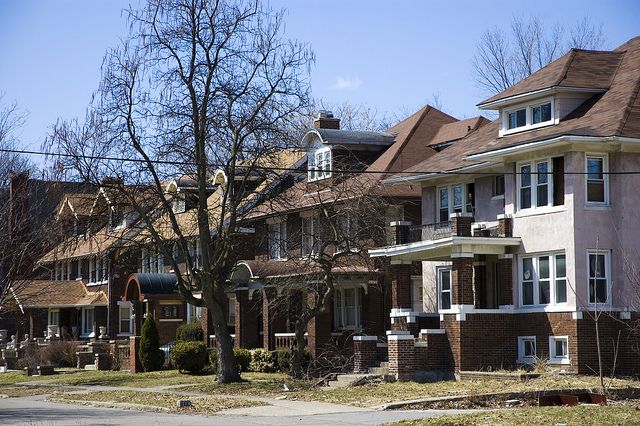Count President Obama among those with a vision for the future of Detroit.
In his second inaugural address on Monday, Obama proclaimed that our journey as a free American people is not complete “until all our children, from the streets of Detroit to the hills of Appalachia to the quiet lanes of Newtown, know that they are cared for and cherished and always safe from harm.”
But, for the “streets of Detroit,” what’s it going to take? The city’s challenges have been exhaustively chronicled — vacancy, crime, arson, underemployment — but those with ideas for changing its trajectory, outside of pet projects, have been less forthcoming. And, lest we forget, hundreds of thousands of real human lives are on the line. Excitement about transformed central neighborhoods, as well as the urban agriculture and arts communities that are reimagining the city’s empty spaces, is not enough.
Which is why Detroit Works emerged. Intended to bring residents into the planning of the city’s future, the two-year collaborative outreach effort yielded feedback from 150,000 Detroiters. Through interviews, community discussions, a hotline, a video game, a staffed roving cart set up in farmers markets and street corners, and a storefront “home base” with an open door, the project managed to move past long-held tensions over proposals to shrink the city’s footprint.
The result: Detroit Future City, a 50-year blueprint for how good decisions can be made at all levels, from the offices of mayors and CEOs to the living rooms of block club presidents and PTO presidents. (Access the full 374-page report here.)
The focus is on six planning elements:
- Economic Growth (“Detroit is not too big; its economy is too small.”)
- Neighborhoods (“Detroit must be welcoming to all, including those moving in from neighboring cities, those who are originally from other countries, and those with limited means.”)
- City Systems (“The key is to be smart about how and where we locate and reinforce residential areas, employment and other activities.”)
- Land Use (“To be sure, a traditional ‘build it and they will come’ approach is not going to work for Detroit.”)
- Land and Buildings Assets (“Turning vacant land from burdens to assets will take more than changes in specific policies and practices.”)
The release of the final Detroit Works framework — rebranded upon its debut as Detroit Future City — is inciting a good deal of medi attention. In an interesting conversation on The Craig Fahle Show on WDET, a local public radio station, the question became, “What is urban space for?”
But now comes the itchy question of implementation. What, really, is going to happen, if anything? Even if there is public will behind this vision, where do you begin in turning such a comprehensive strategy into on-the-ground projects? Can this jargon-heavy, if beautifully designed, report actually touch the lives of ordinary Detroiters, who are just trying to navigate streets with patchy lighting so they can get their kids to school?
The Kresge Foundation announced it will put $150 million over five years toward hundreds of implementation projects, on top of the deep support they’d put behind the planning process. In a nice bit of synchronicity, Detroit also received $25 million in federal funds last Friday to support the building of a light rail system. Unsurprisingly, integrated public transit is among Detroit Future City’s recommendations.
According to the Detroit Free Press, additional pledges for implementation funds came from the Ford, Knight, Kellogg, Erb and Hudson-Webber foundations, as well as the Community Foundation for Southeast Michigan, though it’s not clear what their collective total is.
Kresge and Kellogg will together give a further $3 million to the Detroit Economic Growth Corporation, which, “as official caretaker of the Detroit Future City report, hire a project team to oversee the first steps in implementing the recommendations,” according to the Free Press. That leadership team should be assembled by the end of the month, said George Jackson, DEGC president and CEO.
“This isn’t something we intend to sit around on. We expect that effort to get under way quickly through the program office — within weeks,” Jackson told Crain’s Detroit Business. “It’s important to continue with and take advantage of the momentum the plan has already created.”
There is no specific price tag on what implementation will take, and its makers never tried to calculate it; they emphasized that the framework is pragmatically tailored to amplifying existing resources rather than relying on an infusion of cash. Nonetheless, philanthropic support will help launch tangible pilot projects that the Future City team wants to see completed swiftly enough to sustain public support, not to mention the support of city leaders. Detroit, after all, may have a new mayor by the end of the year.
What are those pilot projects going to be? No word yet. But what’s true is that Detroit may be on the brink of the kind of restructuring seen in no other American city with such intention or urgency. While there is a lot that is joyful and inspiring here — I choose it as my home for a reason — Detroit’s problem is not one of branding and cheerleading will not solve it.
Along the same lines, it’s crucial for the team behind Detroit Future City to not cease its engagement conversations with those who live and work here just because the report is printed and bound. For the vision on its pages to actualize, its makers need to speak the language of the people, letting go of planning jargon to speak directly about the forces that have formed these “streets of Detroit,” where all our children are not, yet, always safe from harm. Poverty, racism, segregation, inequality, bureaucracy, corruption: Speak it plainly. Articulate the vision of the report’s 374 pages into a concise sentence that is galvanizing, a touchstone that inspires citizens and is easily passed on.
This way, when the Detroit Future City pilot projects take shape, they do so not only with an unprecedented planning effort behind them, but with unprecedented democratic support.

Anna Clark is a journalist in Detroit. Her writing has appeared in Elle Magazine, the New York Times, Politico, the Columbia Journalism Review, Next City and other publications. Anna edited A Detroit Anthology, a Michigan Notable Book. She has been a Fulbright fellow in Nairobi, Kenya and a Knight-Wallace journalism fellow at the University of Michigan. She is also the author of THE POISONED CITY: Flint’s Water and the American Urban Tragedy, published by Metropolitan Books in 2018.
Follow Anna .(JavaScript must be enabled to view this email address)






_600_350_80_s_c1.JPEG)









